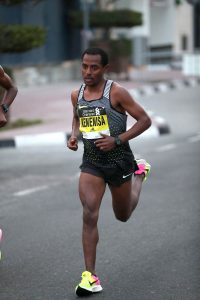We have all noticed how elite runners tend to lift their foot high towards the buttock: Bekele is a perfect example (see photo).
You would think that through hard training they developed very powerful hamstrings to be able to do this. But this is not the case: the hamstrings play a very important role in the running technique but not this one.
The lift of the foot is above all and mainly the consequence of a passive movement of the runner which is linked to five factors:
- speed: the higher the speed, the greater the force of rebound (Newton’s 3rd law: the action is always equal to the reaction; in this case, the force applied by the runner on the ground generates a reaction force of equal value)
- the direction of the foot’s path at impact: if the foot is in a forward-to-backward path before contact with the ground (as it should be with good running technique), the foot will bounce higher
- the distance between the foot’s contact with the ground and the pelvic line: the closer the point of contact is to the pelvis line, the more the reaction force of the ground will be directed backwards, thus facilitating the rebound of the foot. Thus runners who have a heel pose tend to have a foot that does not rise very high because they tend land their foot further away in front of them than runners who are more midfoot or even forefoot. This also creates a specific biomechanical circle: the more the foot is placed in front and the less the foot rises high: the runner must therefore pose far ahead to keep length in his stride. In fact, if the runner, putting his foot far in front of him, tries to lift his foot high towards his buttock, he will have to strain his hamstrings a lot and run the risk of harming that muscle.
- the runner’s flexibility: if the runner’s quadriceps are very stiff, it will be more difficult for him to bring his foot towards his buttock.
- the weight of the runner’s lower leg: the greater the mass of this part of the leg (including the shoe), the more force it will take to lift the foot: the runner’s age also often has a effect on the foot lift: young people (especially teenagers) have thin and flexible legs: their foot tends to rise significantly higher than adults at equivalent speed (despite not particularly powerful hamstring).
In view of these five factors, strengthening your hamstrings to lift the foot higher is not very interesting: it is much more interesting to work on body movements, stretch and run with light shoes. .
There are often significant differences between runners in foot lift at equal speed. This is a very interesting indicator for determining the strengths and weaknesses of their stride and advising them on the most suitable running gait and also the best arm position.
In other articles, we’ll talk about whether or not to lift the foot high towards the buttock.
Now is the time to practice your technique!

